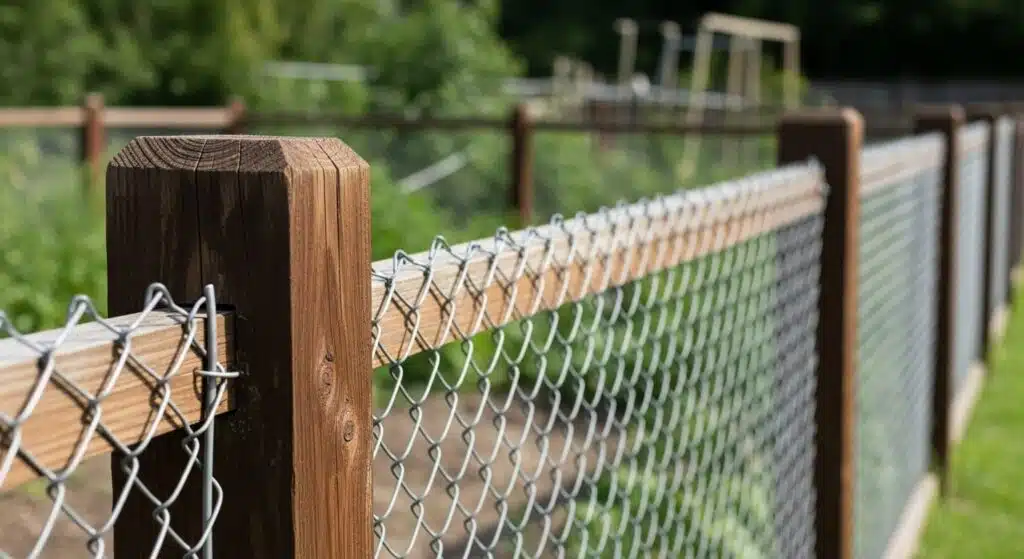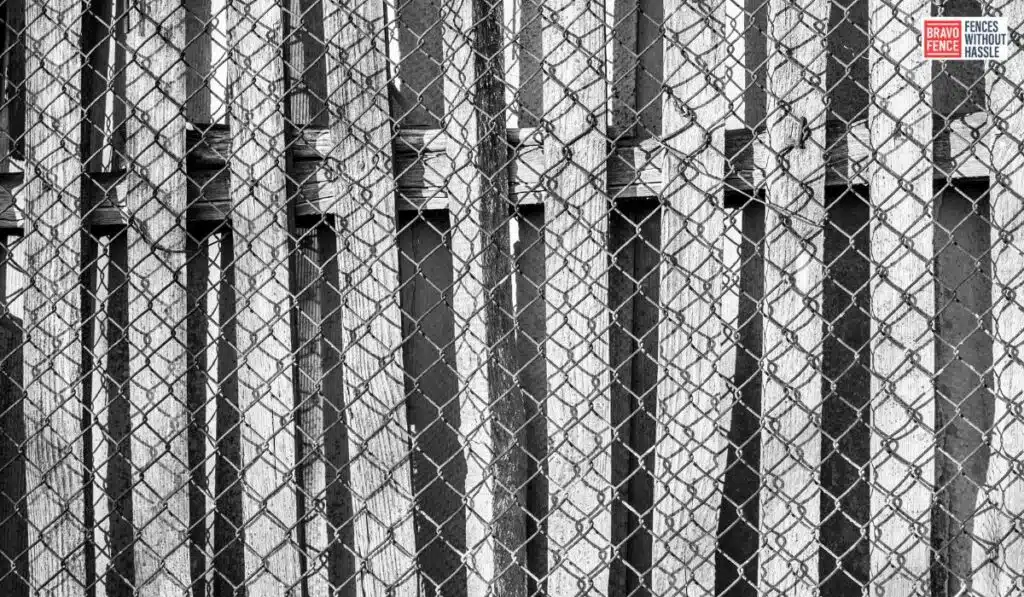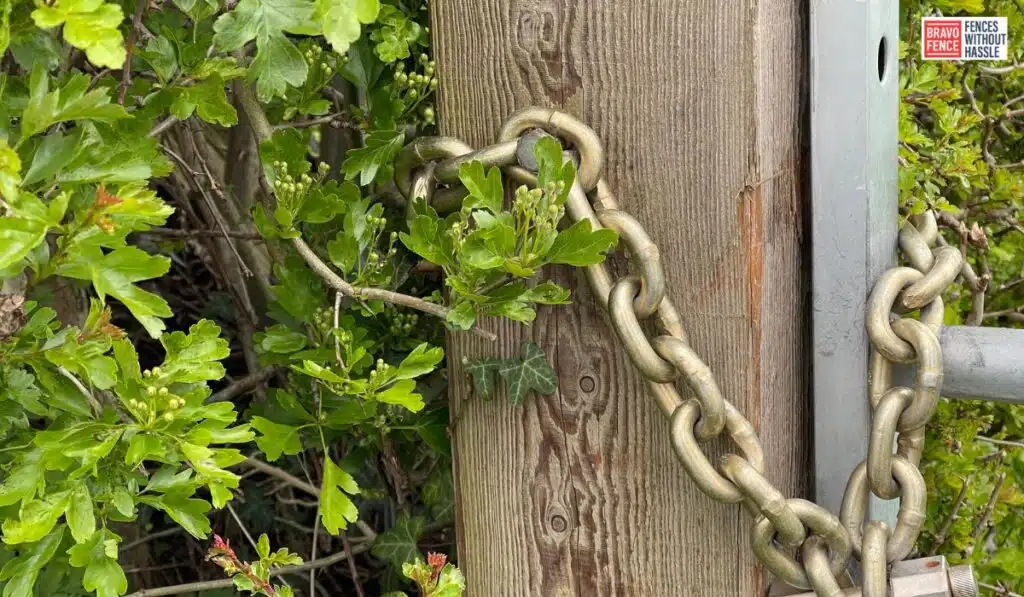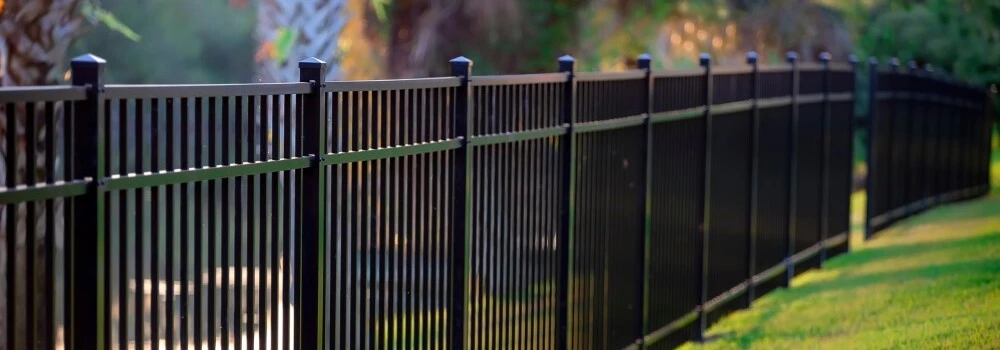
Installing a Chain Link Fence Using Wood Posts: A Step-by-Step Guide
Installing a chain link fence with wood posts is a straightforward process that requires careful planning and execution. By following these steps, you can ensure a successful installation:
Step 1: Gather the Necessary Materials
Before starting the installation, gather all the materials you’ll need, including chain link fabric, wooden posts, concrete mix, tension bands, post caps, gate hardware, and tools such as a post hole digger, level, and pliers.
Step 2: Plan and Mark the Fence Layout
Determine the boundaries of your fence and mark them with stakes. Use a measuring tape to ensure accurate placement of the fence posts. Consider the terrain, slope, and any obstacles that might affect the fence’s alignment.
Step 3: Dig the Fence Post Holes
Using a post hole digger, dig holes for the wooden posts at regular intervals along the fence line. The depth of the holes should be approximately one-third of the total height of the fence, plus 6 inches for gravel.
Step 4: Set the Wooden Posts
Place a wooden post in each hole and ensure they are plumb and level. Use braces and a level to keep them in position. Fill the holes with concrete mix, following the manufacturer’s instructions. Allow the concrete to set before proceeding.
Step 5: Install the Chain Link Fabric
Unroll the chain link fabric along the fence line, starting at one end. Attach it to the wooden posts using tension bands and bolts. Ensure the fabric is taut and secure. Use pliers to tighten the tension bands and remove any excess slack.
Step 6: Add Gate Hardware
If you plan to include a gate in your chain link fence, install the gate hardware according to the manufacturer’s instructions. This may involve attaching hinges, latches, and other necessary components. Ensure the gate operates smoothly and securely.
Step 7: Finishing Touches
Once the chain link fabric and gate are installed, add post caps to the wooden posts for a polished look. Inspect the entire fence for any loose connections or areas that require additional reinforcement. Make any necessary adjustments or repairs.
Advantages of Wood-Post Chain Link Fences

When considering different fencing options, a chain link fence with wood posts offers several advantages:
- Affordability: In terms of cost-effectiveness, chain link fences with wood posts generally outperform other types of fencing materials. This makes them an attractive choice for those on a budget.
- Durability: Chain link fences are known for their durability and longevity. When combined with sturdy wooden posts, they can withstand various weather conditions and provide long-lasting security.
- Versatility: You can install chain link fences in various settings, ranging from residential properties to commercial areas. They can adapt to different terrains and are suitable for enclosing large or small areas.
- Low Maintenance: Unlike fences made of wood or other materials that require regular painting or staining, chain link fences with wood posts are relatively low maintenance. They do not rot or warp, and occasional cleaning is usually sufficient to keep them looking good.
- Security: Chain link fences, when properly installed and combined with appropriate gate hardware, can provide an effective barrier, enhancing the security you can afford of your property.
- Visibility: Chain link fences offer visibility both inside and outside the enclosed area. This can be advantageous if you want to maintain a clear line of sight or showcase the aesthetics of your property.
- Compatibility with Vegetation: The use of wooden posts in a chain link fence allows for compatibility with climbing plants or shrubs. This can enhance the visual appeal of the fence and provide additional privacy.
Steps to Install Chain Link Fence and Posts
Installing a chain link fence with wood posts involves several steps. Here are the key steps you need to follow:
- Planning and Preparation: Determine the fence layout, mark the boundaries, and gather all the necessary materials and tools.
- Digging the Post Holes: Use a post hole digger to create holes for the wooden posts at regular intervals along the fence line. Ensure the holes are deep and wide enough to provide stability.
- Setting the Wooden Posts: Place the wooden posts in the holes and ensure they are plumb and level. Use braces and a level to keep them in position. Fill the holes with concrete mix and allow it to set.
- Attaching the Chain Link Fabric: Unroll the chain link fabric along the fence line and attach it to the wooden posts using tension bands and bolts. Ensure that you stretch the fabric tightly and secure it properly.
- Adding Gate Hardware: If you plan to have a gate in your chain link fence, install the necessary gate hardware, including hinges, latches, and locks, according to the manufacturer’s instructions.
- Finishing Touches: Inspect the entire fence for any loose connections or areas that require reinforcement. Make adjustments or repairs as needed. Add post caps to the wooden posts for a polished look.
Tips to Maintain Your New Fence Posts
To ensure the longevity and durability of your chain link fence with wood posts, follow these maintenance tips:
- Regular Inspections: Periodically inspect the fence for any damage, loose connections, or signs of wear. Address any issues promptly to prevent further damage.
- Cleaning: Clean the chain link fabric and wooden posts regularly to remove dirt, debris, and any buildup. Use a mild detergent and a soft brush or cloth for cleaning.
- Vegetation Control: Trim any plants or vegetation growing near the fence to prevent them from causing damage or interfering with the fence’s stability.
- Repairs and Replacement: If you notice any broken or damaged parts, such as tension bands or posts, repair or replace them as necessary to maintain the integrity of the fence.
- Protective Coating: Consider applying a protective coating or sealant to the wooden posts to enhance their resistance to moisture, pests, and rot.
- Winter Preparations: In areas with harsh winters, take measures to protect your fence from snow and ice. Clear snow buildup and remove ice carefully to prevent damage.
- Avoiding Heavy Loads: Avoid placing heavy objects or leaning heavy equipment against the fence, as this can cause stress and damage to the posts and fabric.
- Professional Maintenance: If you’re unsure about any maintenance tasks or require major repairs, it’s advisable to consult a professional fencing contractor for assistance.
By following these maintenance tips, you can prolong the lifespan of your chain link fence with wood posts and ensure it continues to serve its intended purpose effectively.
Durable Chain Link Fence

Congratulations on successfully installing your chain link fence with wood posts! With its affordability, durability, and low maintenance requirements, you now have a secure and functional fencing solution that can enhance the aesthetics and value of your property.
Whether you’re looking to enclose your backyard, secure a commercial area, or create a safe space for pets and children, a chain link fence with wood posts offers numerous benefits. Its versatility, compatibility with climbing plants, and visibility make it an attractive choice for various applications.
Whether you chose a chain link fence with wood posts for its affordability, versatility, or durability, you’ve made a wise investment. It’s a fencing solution that can withstand the test of time and serve its purpose effectively.
As you enjoy your new fence, take a moment to appreciate the craftsmanship and effort that went into its installation. Your careful planning, precise measurements, and attention to detail have resulted in a fence that not only meets your functional needs but also adds value to your property.
FAQs
Can you attach a chain link fence to a wood post?
Yes, it is possible to attach a chain link fence to a wood post. People commonly use this method to combine the strength and durability of chain link fabric with the aesthetic appeal of wooden posts. Proper installation techniques, such as using tension bands and bolts, ensure a secure attachment between the chain link fabric and the wood posts.
Is it cheaper to build a wood fence or chain link?
Generally, people consider chain link fences to be more affordable than privacy fences. The materials required for a chain link fence, such as chain link fabric, tension bands, and posts, are often less expensive than the materials needed for a wood fence, such as wooden boards and posts. Additionally, chain link fences require less labor-intensive installation, further contributing to their cost-effectiveness.
How do you attach a metal fence to a wood post?
To attach a metal fence to a wood post, you can use specialized brackets designed for this purpose. These brackets typically feature pre-drilled holes for attaching the metal fence panels to the wooden post. Secure the brackets to the post using screws or nails, ensuring a sturdy connection. Follow the manufacturer’s instructions for specific guidance on attaching a metal fence to a wood post.
How do you attach a wood fence to chainlink?
To attach a wood fence to a chainlink fence, you can use various methods. One common approach is to install wooden boards, known as “slats,” through the chainlink mesh. These slats are typically secured to the chainlink using wires or fasteners. Alternatively, you can build a wooden frame around the chainlink fence and attach the wooden boards to the frame. Choose a method that suits your preferences and ensures a secure attachment between the wood fence and the chainlink.
Can you install chain link fence post without concrete?
While concrete is commonly used to secure chain link fence posts, it is possible to install them without concrete. There are alternative methods such as using gravel or crushed stone as a stabilizing agent in the post holes. The gravel or crushed stone provides stability and drainage for the posts. However, it’s important to note that for the optimal strength and longevity of the fence, concrete is generally recommended.
How far apart should T posts be for a chain link fence?
The spacing of T-posts for a chain link fence depends on various factors, including the height of the fence and the level of stability required. As a general guideline, T-posts should be spaced approximately 6 to 8 feet apart along the fence line. However, for taller fences or areas with high wind loads, closer spacing may be necessary to ensure the fence remains sturdy and secure.
How much does it cost to install 400 feet of chain link fence?
The cost of installing a 400-foot chain link fence can vary depending on factors such as the quality of materials, labor costs in your area, and any additional features or requirements. On average, the cost can range from $4,000 to $7,000 or more. It’s advisable to obtain quotes from different contractors to get a more accurate estimate based on your specific circumstances.
Does a chain link fence decrease property value?
A chain link fence alone typically does not significantly increase or decrease property value. The impact on property value depends on various factors, including the condition of the fence, its purpose (such as security or aesthetics), and the overall appeal of the property. In some cases, a well-maintained and aesthetically pleasing chain link fence can enhance the curb appeal and potentially increase the property value.
What are the disadvantages of a chain link fence?
While chain link fences have their advantages, they also have a few disadvantages to consider. Some common drawbacks include:
- Limited privacy: Chain link fences do not provide adequate privacy due to their open design.
- Lack of aesthetic appeal: Chain link fences are often considered less visually appealing compared to other fence types, such as wooden or vinyl fences.
- Limited noise reduction: Chain link fences do not offer significant noise reduction properties, which may be a concern if you live in a noisy neighborhood.
- Potential for rust and corrosion: Over time, chain link fences may experience rust and corrosion, especially in areas with high moisture or salt exposure. Regular maintenance and protective coatings can help mitigate this issue.
- Limited security for small animals: If you have small pets, such as small dogs or cats, there is a possibility that they can squeeze through the gaps in the chain link fabric.
- Difficulty in blocking wind: Chain link fences are not as effective in blocking wind compared to solid fences. This may be a consideration if you live in an area prone to strong winds.
What’s the cheapest fence to install?
In general, people consider chain link fences to be one of the most affordable options for fence installation. The materials needed for chain link fences, such as chain link fabric, posts, and accessories, often have lower costs compared to other fence types like wood or vinyl. Additionally, chain link fences typically require less labor-intensive installation, further contributing to their cost-effectiveness.
How do you install fence panels in an existing wooden post?
To install fence panels in an existing wooden post, follow these steps:
- Measure the width of the fence panel and ensure it fits between the existing wooden posts.
- Attach brackets or clips to the wooden posts, following the manufacturer’s instructions. These brackets or clips will secure the fence panels to the posts.
- Position the fence panel between the posts, aligning it with the top and bottom rails of the panel.
- Secure the fence panel to the brackets or clips using screws or nails. Ensure a tight and secure connection.
- Repeat the process for each fence panel, ensuring proper alignment and secure attachment to the existing wooden posts.
Do metal fence posts need concrete?
You can install metal fence posts with or without concrete, depending on the level of stability and durability desired. While people commonly use concrete to secure metal fence posts, stability can also be achieved through alternative methods such as using gravel or crushed stone.
Concrete is recommended for optimal strength and longevity, especially for taller or heavier-duty fences. However, in certain situations, such as temporary or lightweight fences, using gravel or crushed stone may be sufficient.
How much does a 50-foot roll of chain link fence weigh?
The weight of a 50-foot roll of chain link fence can vary depending on factors such as the gauge of the wire and the height of the fence. On average, a 50-foot roll of standard residential-grade chain link fence with a height of 4 feet weighs approximately 40 to 50 pounds. However, for heavier gauge fences or taller heights, the weight may increase accordingly.
How do you secure a chain link fence to a post?
To secure a chain link fence to a post, follow these steps:
- Attach tension bands to the end or corner posts. These tension bands will hold the chain link fabric in place.
- Unroll the chain link fabric along the fence line, ensuring it is positioned correctly.
- Slide the tension bar through the links of the chain link fabric, starting from the top.
- Secure the tension bar to the tension bands using carriage bolts or self-locking nuts.
- Use fence ties or hog rings to secure the chain link fabric to the top rail, bottom rail, and line posts at regular intervals.
- Adjust the tension of the chain link fabric using a come-along or fence stretcher, ensuring it is taut and free from sagging.
- Repeat the process for each section of the fence, ensuring a secure attachment between the chain link fabric and the posts.
How can I secure the bottom of my chain link fence?
Securing the bottom of a chain link fence is important to prevent small animals from squeezing underneath and to maintain the overall integrity of the fence. Here are some methods to secure the bottom of your chain link fence:
- Install a bottom tension wire: Attach a tension wire along the bottom of the chain link fabric, weaving it through the links and tightening it to provide added stability and prevent animals from pushing their way under the fence.
- Use a bottom rail: Install a bottom rail made of metal or wood along the base of the chain link fence. This rail helps keep the bottom of the fence in place and provides a barrier for animals trying to enter or exit.
- Bury the bottom of the fence: Dig a shallow trench along the fence line and bury the bottom portion of the chain link fabric. Ensure that the fabric extends below the ground surface to prevent animals from digging under the fence.
- Attach a kickboard: Install a wooden or vinyl kickboard along the bottom of the fence, securing it to the posts. This not only provides added stability but also acts as a barrier to prevent animals from entering or damaging the fence.
Choose the method that best suits your needs and ensures the bottom of your chain link fence is securely sealed.
How deep should chain link fence posts be buried?
The depth at which chain link fence posts should be buried depends on various factors, including the height of the fence, the soil conditions, and the local climate. As a general guideline, fence posts should be buried at least one-third of their total length.
For example, if you have a 6-foot chain link fence, the posts should be buried approximately 2 feet deep. This depth provides stability and ensures the posts can withstand the forces applied to the fence, such as wind or tension from the chain link fabric.
Should wooden fence posts be set in concrete?
Setting wooden fence posts in concrete is a common practice to ensure stability and longevity. Concrete provides a solid foundation, preventing the posts from shifting or leaning over time. When setting wooden fence posts in concrete, it’s important to dig a proper post hole, place the post securely in the hole, and pour concrete around it.
This method helps protect the bottom of the post from moisture and extends its lifespan. However, alternative methods like using gravel or crushed stone as a stabilizing agent can be used if concrete is not desired or suitable for your specific circumstances.
How deep should a 6-foot chain link fence post be?
For a 6-foot chain link fence, the posts should typically be buried at least 2 feet deep. This depth ensures fence stability, withstanding wind and tension from the chain link fabric. However, consider soil conditions and local codes, which may require deeper post holes or additional measures for stability.
What is the easiest fence to install yourself?
Chain link fences are often considered one of the easiest types of fences to install yourself. They require relatively straightforward techniques, such as setting the posts, unrolling the chain link fabric, and securing it in place. Compared to other fence types, chain link fences involve fewer intricate steps, specialized tools, or complex construction techniques.
Should fence posts be 6 or 8 feet apart?
The spacing between fence posts depends on various factors, including the type of fence, the height of the fence, and the desired level of stability. As a general guideline, fence posts are typically spaced 6 to 8 feet apart for chain link fences. However, for taller or more heavy-duty fences, closer spacing between posts may be necessary to ensure the fence remains stable and secure.
It’s important to consult local building codes and regulations to determine the specific requirements for your area. Additionally, when determining the spacing between fence posts, it is important to consider factors such as soil conditions, wind load, and the type of terrain. Properly spaced posts provide structural integrity to the fence and help distribute the load evenly along the fence line.
Do I need a permit to put a fence around my yard?
The need for a permit to install a fence around your yard depends on various factors, including your location, local regulations, and the type of fence you intend to install. In many jurisdictions, permits are required for fences that exceed a certain height, typically around 6 feet or higher.
Additionally, there may be setback requirements that dictate how far the fence must be from property lines or public rights-of-way. It’s important to contact your local municipality or building department to inquire about the specific regulations and permit requirements for installing a fence in your area. Obtaining the necessary permits ensures compliance with local laws and helps prevent potential issues or fines in the future.
How many rolls of chain link can fence an acre?
The number of rolls of chain link fence needed to enclose an acre depends on various factors, including the desired height of the fence and the specific dimensions of the acreage. To calculate an estimate, you’ll need to know the length of the perimeter where the fence will be installed. Since one acre is equal to 43,560 square feet, you can use the following formula:
Perimeter Length (in feet) = √(Acreage * 43,560)
Once you have the perimeter length, divide it by the length of a roll of chain link fence to determine the number of rolls needed. Keep in mind that this calculation assumes a standard roll length of 50 feet or 100 feet. Additionally, we recommend adding extra rolls for corners, gates, or any areas that require additional fencing. Consulting with a professional fence installer can help provide a more accurate estimate based on your specific needs and requirements.
Is a chain link fence more expensive than a privacy fence?
In general, chain link fences as more affordable when compared to privacy fences. Chain link fences require less material, as they consist mainly of chain link fabric, posts, and accessories. Privacy fences, on the other hand, typically involve more substantial materials, such as wooden boards or vinyl panels, which can contribute to higher costs.
Additionally, privacy fences often require more labor-intensive installation due to the need for precise placement of individual panels or boards.
The fence cost varies based on material quality, height, length, and local labor. Obtaining quotes from contractors and comparing fence costs can guide your decision based on budget and preferences.
Tags: Complete Guide to How To Repair Chain Link Fence, Everything You Need to Know About Chain Fence Repair, Everything You Need to Know About Chain Link Fence Repair, Explore Helpful Resources on Chain Link Fence, Explore Helpful Resources on Chain Link Fence Repair Kit, Inspiration and Tips on How To Repair A Chain Link Fence, Inspiration and Tips on Repair Chain Link Fence, Top Ideas and Insights About Chainlink Fence Repair, Top Ideas and Insights About How To Install Chain Link Fence With Wood Posts, Top Ideas and Insights About Install Chain Link Fence, Top Ideas and Insights About Repair Bent Chain Link Fence

